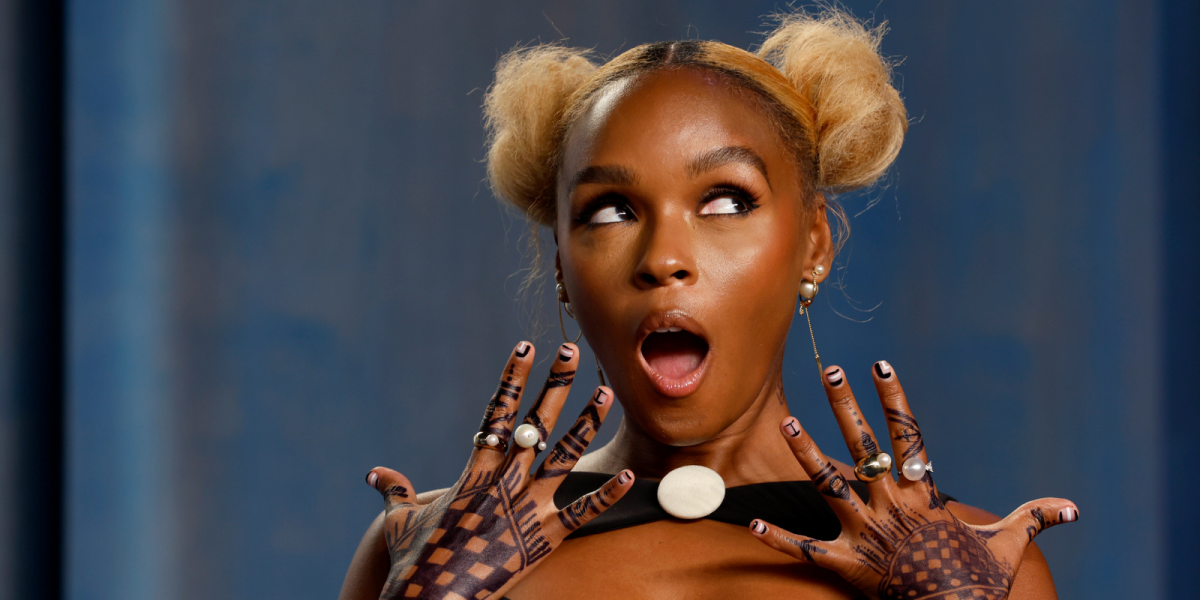Feature Image of Janelle Monáe photo by Timothy Hiatt/WireImage/Getty Images
In a short yet powerful episode of Red Table Talk, the magical, multifaceted, and highly talented Janelle Monáe announced that she identifies as non-binary! Upon learning this news, my heart overflowed with unwavering joy, warmth, and pride. I have always felt represented by Janelle Monáe’s art, and as a Black and non-binary ArchAndroid myself, this takes it to an elevated level. It felt overwhelmingly special to know that the person who helped shape the understanding of my own identity, has undergone a parallel journey to discovering her own divine truths.
Monáe shares their journey to understanding their identity as a Black pansexual, non-binary, free-ass motherfucker—which includes getting to a point where she felt comfortable sharing her identities with their family and the world. As they recount this journey to the Pinketts/Smiths, they reveal how this process is not merely about identity; it’s also about self-worth and the path to self-acceptance and truth—which is neither straightforward nor easy. Beginning in her childhood, this path involved the process of daring to follow her dreams in a world that has always wanted her to conform to traditional ideals. By embracing their identities, Monae is merely embracing their whole self by refusing to be anyone else, explaining:
“I had to be where I was. I know who I am. I’ve been playing a version of some parts of me but now I’m owning all of me. I had to own all of me to really be able to talk about it publicly.”
As the talk wraps up, she discusses the role of representation in her art when she surprises a super fan. Monáe explains the importance of using their art to help other queer folks find love and care within it—and within this difficult world— by boldly being their true selves on their own terms. I feel I can earnestly vouch for her power. I grew up enamored with her music and art, but just recently embraced my identity as a Black non-binary femme.
It feels so sacred and special to be able to learn, write, and reflect in this way about Janelle Monáe, who greatly influenced my own journey in regard to my sexuality and gender identity. Her art watered the seeds of political audaciousness, freedom, and self-love that had been planted in my soul. It feels serendipitous to witness her unapologetic declaration of her whole being, including her art, while the seeds within myself have blossomed into self-acceptance and power as a being and as a writer. In the same way that Monáe uses their art, to empower themselves and others, I work to do the same. In our own separate universes, we have both grown from being “Lil’ pumpkins” to our mothers, to being loved for our truest selves in front of the world.
Growing up, I looked to her as a Black femme musician whose art and existence challenged traditional definitions of Black womanhood. They have always embodied self-love, creativity, and power. Janelle Monáe’s art is an audacious love letter to Black queer folks who dare to break the cisheterosexual mold that is expected of them. I grew up around Southern religious conservatism from some of my family members and during that time, Q.U.E.E.N. was my anthem. I have such vivid memories of my 14-year-old closeted self belting her lyrics; “Hey sister am I good enough for your heaven? Say will your God accept me in my black and white? Will he approve the way I’m made? Or should I reprogram, deprogram, and get down?”

Photo: Frazer Harrison/Getty Images.
When I reflect back on the impact of Monáe’s art on my own journey, I can’t help but see her lyrics as musical manifestations. As melodies of support that helped build so much of my strength and confidence as a young Black queer child. I can draw a clear connection between the evolution of my ability to speak my truths and the presence of their art. Their entire discography is a collection of powerful, soulful, genre-bending sounds that melodically and lyrically show how she has grown into her power and truth over time.
On my journey, I learned that in order to embrace myself, I had to do (and still continue to do) self-work that allowed me to see and welcome my own truths. Battling against internalized norms regarding race and gender, I became increasingly able to peel back the societal layers and interrogate these false, unhealthy notions that hindered my ability to be and love myself. Rather than change myself to fit society’s boxes, I learned to accept how profound and multifaceted my soul is. I eventually came to understand that “Black womanhood” alone does not and cannot capture my true being. While I will always view myself in community with Black women, I now embrace myself beyond the binary.
By sharing her soul and truth with us, Janelle Monáe’s art inspires folks to dream big, to embrace our personal truths, and to always cultivate love for ourselves. I am so thankful for and appreciative of not only Monae’s art, but also their radical vulnerability, self-acceptance, and love. The public declaration of their non-binary identity challenges us all to “reprogram, deprogram, and get down” on our journeys to divine personal growth.



Amari, just wanted to compliment you on this short but fantastic read. Thank you:)
This was excellent! Thank you for sharing!